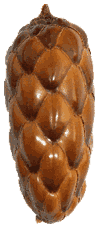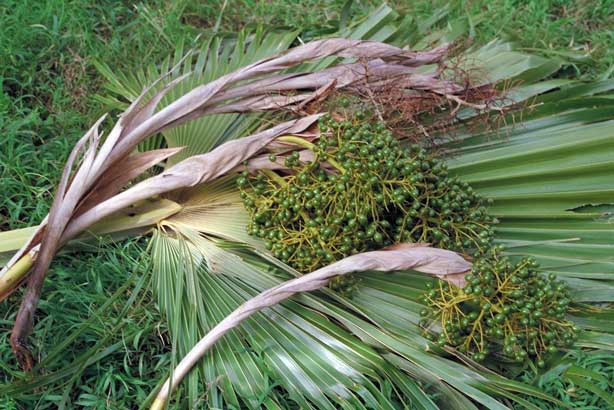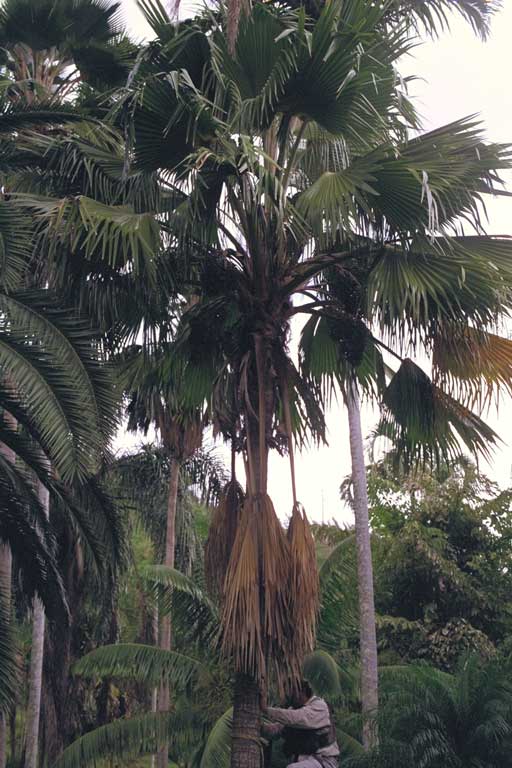 |
Palm |
 |
Palm |
 |
| Materials of Pritchardia aylmer-robinsonii collected for making a voucher specimen for the herbarium. |
Niihau, Hawaii, USA
Pritchardia aylmer-robinsonii is a medium palm, 715 m in height. The trunk is 2030 cm DBH, dark gray with close rings left by leaf scars, and vertical fissures. The dense crown is made up of many bright green, glabrous, ascending, spreading leaves. The thin pinnae have pendulous ends. The inflorescences are shorter than the leaves. The fruit is dark brown to black when ripe and globose 22 x 20 mm.
Pritchardia aylmer-robinsonii was discovered by Harold St. John in 1947. The two remaining wild trees occur in a rugged, steep cliff area in Mokouia and Haao Valleys, at 70270 m elevation, originally a component of the coastal dry forest. Niihau, or the forbidden island, is an inhabited, privately owned island. Pritchardia aylmer-robinsonii is the only palm species endemic to Niihau. They produce almost 100% viable seed if collected when ripe, yet they do not reproduce in the wild. Introduced honey bees (Apis mellifera) and possibly wind contributes to their successful pollination. Of the two trees, only one has been observed producing flowers or fruits.
Predation of P. aylmer-robinsonii seeds occurs from introduced rats (Rattus rattus, R. exulans, and R. norvegicus). Habitat destruction from introduced vertebrates such as deer (Odocoileus hemionus columbianus), goats (Capra hircus), and pigs (Sus scrofa) also limits recruitment of P. aylmer-robinsonii seedlings. Cattle from surrounding ranches graze and disrupt the habitat. Invasive weeds such as grasses (Paspalum conjugatum) and guava (Psidium guajava, P. cattleianum) can form weed mats and out-compete young palm seedlings. Pests and disease are a constant threat. Existing threats include the two-spotted leaf hopper (Sophonia rufofascia), and Phytophthora, as well as serious potential threats if introduced, such as the West Indian sugarcane borer (Metamasius hemipterus) or Lethal Yellowing disease and its known vector the palm cixiid (Myndus crudus).
Pritchardia aylmer-robinsonii is widely cultivated by residents on Niihau, with abundant seed production. It is also among the most widely cultivated ornamental palms on the island; moreover, it is found in private collections as well as 33 botanic gardens internationally. Strategies for successful tissue culturing and preservation of samples have been devised by the University of Hawaii, Lyon Arboretum, USA. The United States Fish and Wildlife Service (USFWS) have produced in detailed researched recovery plans for P. aylmer-robinsonii, and it is recognized by the Center for Plant Conservation (CPC), which provides educational awareness.
Recommended management strategies include: protection of in situ populations, adding rat baiting, invasive weed management, and long-term monitoring; establishment of new wild populations; establishment of effective ex situ populations; collaboration to accomplish conservation biology research; adherence to invasive weeds, pest management, and quarantine procedures. There is a need to establish reliable protocols for seed storage, including effective seed banking as a conservation tool.
 |
| Pritchardia aylmer-robinsonii, habit. |
Melany H. Chapin, Ph.D., Bishop Museum Research Associate, Hawaii, USA.
Beccari, O. & J.F. Rock. 1921.
A monographic study of the genus Pritchardia.
Memoirs Bernice P. Bishop Museum 8: 177.
Chapin, M.H., K.R.Wood, S.P. Perlman & M. Maunder. 2004.
A review of the conservation status of the endemic Pritchardia palms of Hawaii.
Oryx 38: 273-281.
Cuddihy, L.W. & C.P. Stone. 1990.
Alteration of native Hawaiian vegetation.
University of Hawaii Press. Honolulu, Hawaii.
Maunder, M., B. Lyte, J. Dransfield & W. Baker. 2001.
The conservation value of botanic garden palm collections.
Biological Conservation 98: 259271.
Pritchard, H.W., M.I. Daws, B.J. Fletcher, C.S. Gamene, H.P. Msanga & W. Omondi. 2004.
Ecological correlates of seed desiccation tolerance in tropical African dryland trees.
American Journal of Botany 91: 863870.
St. John, H. 1959.
Botanical novelties on the island of Niihau, Hawaiian Islands.
Hawaiian Plant Studies 25. Pacific Science 13: 156190.
Sakai, A.K., W.L. Wagner & L.A. Mehrhoff. 2002.
Patterns of endangerment in the Hawaiian flora.
Systematic Biology 51: 276302.
USFWS. 1996.
Endangered and threatened wildlife and plants; endangered status for the Hawaiian plant Pritchardia aylmer-robinsonii (wahane).
Department of the Interior, Fish and Wildlife Service 61(153): 4102041024.
Wagner, W.L., D.R. Herbst & S.H. Sohmer. 1990.
Manual of the flowering plants of Hawaii 1-2.
Bishop Museum Press, Honolulu, Hawaii, USA.
Wagner, W.L., M.M. Bruegmann, D.M. Herbst & J.Q.C. Lau. 1999.
Hawaiian vascular plants at risk: 1999.
Bishop Museum Occasional Papers, no. 60.
Bishop Museum Press, Honolulu, Hawaii, USA.
Wichman, J.R. & H. St. John. 1990.
A chronicle and Flora of Niihau.
National Tropical Botanical Garden, Lawai, Hawaii, USA.